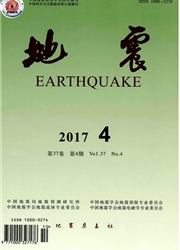

 中文摘要:
中文摘要:
利用龙门山区域重力网经平差处理和去基准点干扰、去高程变化影响的1997-2007年11期重复重力观测数据,借助密度的三维反演方法,分析研究了龙门山地区地壳各深度的介质密度的动态变化特征.结果显示:2008年汶川8.0级地震孕育发生过程中区域密度场的整体时空分布均表现出显著特征.从时间进程来看,震前10年的密度变化趋势呈现阶段性变化:密度变化平稳阶段—变化剧烈阶段(加速增加—缓慢减少)—变化缓慢减少阶段密度变化缓慢增加阶段,密度变化程度由强到弱,表明大地震孕育达到了最后阶段;从空间分布来看,密度变化分布有分散—相对集中的趋势,震前地下密度场具有熵值减小的现象;密度变化剧烈的地方多发生在龙门山断裂带及其以西的川西高原上.此外,随深度的增加,密度变化趋势越来越明显.通过比较分析,在汶川地震前密度变化对重力的影响远远超过高程变化对重力的影响.
 英文摘要:
英文摘要:
Based on repeated gravity observations data from 1996 to 2007 of the Longmenshan gravity network,we first carried out adjustment processing,removing of benchmark interference and impact of elevation changes.Then by using 3-D inversion method to reflect underground density,we analyzed the characteristics of Longmenshan regional dynamic density in the depths of 25 km,20 km and 15 km.The results show that in the Wenchuan earthquake inoculation process,regional density field showed obvious characteristics both in time and space distribution.From the point of time process,the density change trend ten years before the earthquake present periodic change:steady phase,dramatic stage,slowly reduce phase and slowly increase phase.The amount of density changes is from large to small,which shows that earthquake gestation has reached the final stage.From the point of space distribution,density change distribution has a tendency of "dispersion-relative concentration",which shows that before the earthquake underground density field exit entropy decreasing.In addition,the density dramatic change region tends to lie in Longmenshan fult zone and the western Sichuan plateau.Besides,with the increase of depth,the trend of density change is more and more obvious.Through comparative analysis,the influence of density change on gravity is far more than height change.
 同期刊论文项目
同期刊论文项目
 同项目期刊论文
同项目期刊论文
 期刊信息
期刊信息
